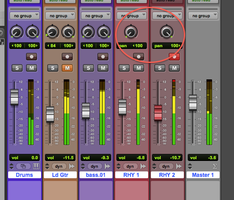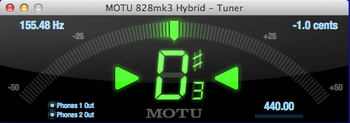One of the most powerful ways to make a track sound bigger and more impactful is by doubling it. The quintessential example of this is the doubled rhythm guitar part, which can really fatten the sound of your mix, and help make the stereo image feel nice and wide throughout the song. But it’s not just rhythm guitar. Doubling is also used to great effect on vocals, both lead and backing, and section parts like horns and strings, and, really any part you want to thicken.
Be precise
It’s important to know your part really well before doubling it, because the key to making it sound good is to be as rhythmically “locked in” as possible with the original part. You don’t want, say, part one hitting right on the downbeat of a measure while part two waits until the second sixteenth-note. That said, because we’re not robots, there will be enough minute natural variations to make the parts distinct enough from each other to sound really big when played back together and panned to opposite sides.
You might be wondering why you couldn’t just duplicate your original part digitally, and use that as the double. The answer is that it would still sound like one part, because it’s too perfectly aligned. If you delayed the duplicated part by a few milliseconds (or pitch shifted it ever so slightly) it would give you some of the same effect as if you played the double, but it wouldn’t sound nearly as good. Try it, you’ll see. There’s something about actually recording the part again that makes it sound so much better.
The right headphone mix is key
One of the best ways to insure that you’ll record a tight doubled part is to make sure you can hear the original part, and yourself really well in the mix. I would suggest muting any unnecessary instruments, everything but the minimum you need for pitch or rhythm reference. It’s also really helpful to pan the original part to one side and the doubled part to the other in your headphone mix. That way, you really hear them as separate parts, which helps a lot for locking in.
Don’t be afraid to use your DAW’s editing features to tighten up the double after the fact, if need be.
Big rhythm
On plenty of rock, pop, and metal songs, you hear doubled power-chord rhythm guitars (sometimes more than just doubled), which sound huge, like a wall of guitars. One of the tricks to getting that big sound is to tune down the guitars for recording the parts. The difference in “bigness” between a rhythm guitar played at concert pitch and one tuned down is significant.
I find that tuning down a half step works well. If you tune down any further, your strings are going to get kind of floppy, and will be harder to play in tune (unless your guitar has heavier-than-average strings, in which case, you probably know all about down tuning, already). Of course, if you’ve tuned down, you’ll have to play the doubled part transposed higher by the same interval as you tuned it down, in order to match the key of the original. That shouldn’t be too tough for most power-chord oriented tracks.
|
Here’s an example of a short rock example (MIDI drums, lead guitar, bass, rhythm guitar) with a single power chord rhythm part, panned mostly center. 00:0000:00  Here’s the same track with a double added of the rhythm guitar, and both panned to opposite sides.
00:0000:00  |
Another consideration is whether you’re going to use the same exact sound on each side, or vary it a little. It depends on what you’re going for. Using the same sound will give you a more homogenous wall of sound, whereas altering the tone — either with a different amp or amp modeler sound or by changing pickups or changing guitars — will sound a little more like two different players were playing. It’s really a matter of what you think will work best for the song. When you’re mixing, try panning the doubled parts anywhere from 3 and 9 o’clock to fully left and right.
Even if you’re not going for a big, high-gain sound, doubled rhythm guitars work well in many types of music. I’ve doubled clean rhythm parts and even acoustic rhythm parts to great effect.
Sing it twice
If you’re doubling a lead vocal in order to thicken it up, you’ll probably want to approach it differently from a mixing standpoint. Because the lead vocal is almost always panned straight up the middle, you’re probably going to want to do the same (or very close to the same) with the doubled lead vocal. In that case, you might want to have the double lower in the mix, just in there enough to fatten it up a little. It will be even more important to make the parts as rhythmically locked in as possible, because you’re not trying to sound like two parts, just one.
Two times is the charm
Doubling is a great tool to have in your arsenal and can provide more sonic “oomph” than most effects you can add after the fact. But, of course, all of these suggestions regarding how to double are just guidelines to give you a good starting point. Feel free to experiment to find your own sound.


